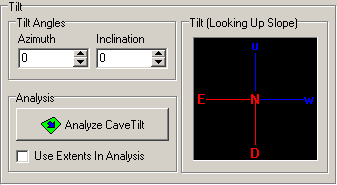Caves are often formed in tilted beds of limestone. When this happens, selecting by depth may not work as well, because certain levels may fall at different depths in different parts of the cave. The Tilt option allows you to tilt the cave so that it is flat. This enables you to select specific layers in caves that have tilted stratigraphy.
Specifying Tilts. You can specify the tilt of the cave in three ways:
1. Azimuth and Inclination. This method allows you to set the tilt based on the direction and slope of the cave. For example, if the cave tilts downward at a 45 degree angle to the east, you would enter 90 degrees for the azimuth and -45 degrees for the inclination. This is the same way a geologist would specify the "Dip" of a rock formation. To set the tilt this way, simply enter the azimuth (compass direction) and inclination in the two edit boxes.
2. Visually. You can also set the tilt visually by dragging the "Compass" in the Tilt Rotations box. To do this, simply drag the "arms" of the "Compass" into position. The azimuth and inclination of the compass always face you. For example, if the cave tilts downward at a 45 degree angle to the east, you would drag the arm labeled "E" toward you and then downward.
3. Analysis. With this method, the program analyzes the cave mathematically and calculates the direction and tilt of the cave. Pressing the “Analyze Cave Tilt” button initiates the analysis and displays the result in the Azimuth and Inclination boxes. The mathematical analysis works very well for caves that have a consistent dip in a particular direction. Caves that don't have a clear tilt to them and caves that are small or single passage caves that run in a straight line can't be analyzed accurately. |
|
Using Extents In Analysis. Enabling this option causes the analysis to focus on the area of the cave defined by the limit lines. This enables you to zero in on certain parts of the cave that are more representative of the overall inclination of the cave. This option uses all six clipping planes that are defined in the limit section no matter how any other options have been set.
Note: Be aware that as you zero in on smaller parts of a cave, it is hard to accurately analyze the tilt. It is also hard to analyze single, straight-line passages.
Applying The Tilt. Once you have specified the tilt, you can view the flatten cave profile on the Position Page.
